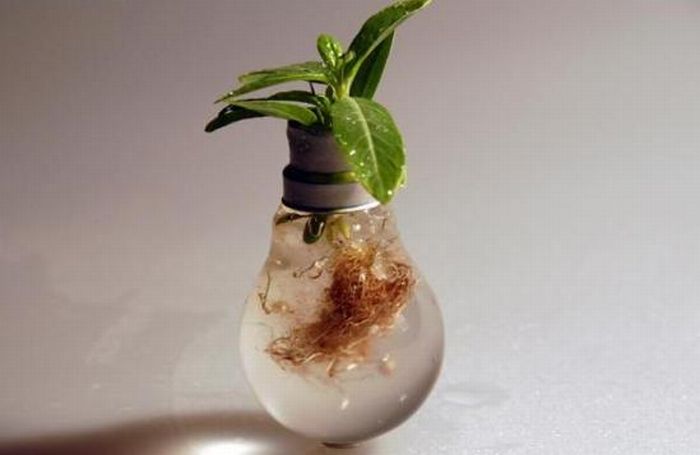|
|
Plants Art From Old Light Bulbs
|
Joseph Swan (1828–1914) was a British physicist and chemist. In 1850, he began working with carbonized paper filaments in an evacuated glass bulb. By 1860, he was able to demonstrate a working device but the lack of a good vacuum and an adequate supply of electricity resulted in a short lifetime for the bulb and an inefficient source of light. By the mid-1870s better pumps became available, and Swan returned to his experiments.
With the help of Charles Stearn, an expert on vacuum pumps, in 1878, Swan developed a method of processing that avoided the early bulb blackening. This received British Patent No 8 in 1880. On 18 December 1878, a lamp using a slender carbon rod was shown at a meeting of the Newcastle Chemical Society, and Swan gave a working demonstration at their meeting on 17 January 1879. It was also shown to 700 who attended a meeting of the Literary and Philosophical Society of Newcastle upon Tyne on 3 February 1879. These lamps used a carbon rod from an arc lamp rather than a slender filament. Thus they had low resistance and required very large conductors to supply the necessary current, so they were not commercially practical, although they did furnish a demonstration of the possibilities of incandescent lighting with relatively high vacuum, a carbon conductor, and platinum lead-in wires. Besides requiring too much current for a central station electric system to be practical, they had a very short lifetime. Swan turned his attention to producing a better carbon filament and the means of attaching its ends. He devised a method of treating cotton to produce 'parchmentised thread' and obtained British Patent 4933 in 1880. From this year he began installing light bulbs in homes and landmarks in England. His house was the first in the world to be lit by a lightbulb and so the first house in the world to be lit by hydroelectric power. In the early 1880s he had started his company. In 1881, the Savoy Theatre in the City of Westminster, London was lit by Swan incandescent lightbulbs, which was the first theatre, and the first public building in the world, to be lit entirely by electricity.
Thomas Edison began serious research into developing a practical incandescent lamp in 1878. Edison filed his first patent application for "Improvement In Electric Lights" on October 14, 1878. After many experiments with platinum and other metal filaments, Edison returned to a carbon filament. The first successful test was on October 22, 1879, and lasted 13.5 hours. Edison continued to improve this design and by November 4, 1879, filed for a U.S. patent for an electric lamp using "a carbon filament or strip coiled and connected ... to platina contact wires." Although the patent described several ways of creating the carbon filament including using "cotton and linen thread, wood splints, papers coiled in various ways," it was not until several months after the patent was granted that Edison and his team discovered that a carbonized bamboo filament could last over 1200 hours.
Hiram S. Maxim started a lightbulb company in 1878 to exploit his patents and those of William Sawyer. His United States Electric Lighting Company was the second company, after Edison, to sell practical incandescent electric lamps. They made their first commercial installation of incandescent lamps at the Mercantile Safe Deposit Company in New York City in the fall of 1880, about six months after the Edison incandescent lamps had been installed on the steamer Columbia. In October 1880, Maxim patented a method of coating carbon filaments with hydrocarbons to extend their life. Lewis Latimer, his employee at the time, developed an improved method of heat-treating them which reduced breakage and allowed them to be molded into novel shapes, such as the characteristic "M" shape of Maxim filaments. On January 17, 1882, Latimer received a patent for the "Process of Manufacturing Carbons," an improved method for the production of light bulb filaments, which was purchased by the United States Electric Light Company. Latimer patented other improvements such as a better way of attaching filaments to their wire supports.
|
|









